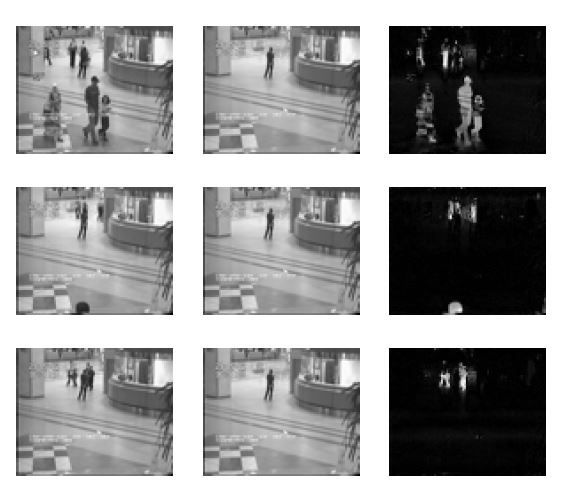论文笔记-Augmented Lagrange Multiplier Method for Recovery of Low-Rank Matrices
论文题目:The Augmented Lagrange Multiplier Method for Exact Recovery of Corrupted Low-Rank Matrices
Abstract
1.Robust PCA问题: recovering a low-rank matrix with an unknown fraction of its entries being arbitrarily corrupted.
RPCA问题是一个凸优化问题:minimizes a combination of the nuclear norm and the L1-norm
2.本文提出一种更好更快的求解RPCA问题的算法:即用 Augmented Lagrange multipliers (ALM) 增广拉格朗日乘子法求解。
比之前用的APD(accelerated proximal gradient)快了5倍,精度也提高了,内存需求也减少了。
3.ALM也用于了 tensor completion
4.Matlab代码: http://perception.csl.illinois.edu/matrix-rank/home.html
Introduction
1.PCA assumes that the given high-dimensional data lie near a much lower-dimensional linear subspace
2.PCA的推导方式挺多的,常见的是方差角度的,这里是另一个角度:
D为 m*n 原数据,A为低秩矩阵,E为它们的差,r 远小于 min(m,n) 为目标子空间维数,目标函数中的 F 范数对应于数据被独立同分布高斯噪声腐蚀的假设。
问题可通过对 D 做 SVD ,取前 r 列向量,再投影。
3.当数据被加性高斯噪声腐蚀时,PCA得到效果很好,在噪声幅值不大的情况下,效果也不错。
如果 A 被任意腐蚀(即E任意大),PCA恢复出的 A 可以任意差。
4.RPCA:
[1]提出当 E 足够稀疏时(相对于A),通过求解如下凸优化问题,可以精确恢复出 A:
第一项为 A 的 nuclear norm (the sum of its singular values),第二项为 L1 范数(the sum of the absolute value of matrix entries),λ is a positive weighting parameter
RPCA对 large errors or outliers,gross corruption 效果也很好,背景建模的应用如下:
5. (2)再转化为一个可以看作普通凸优化问题,用任何 interior point solver 求解,推荐 CVX 工具箱 [2]
但是内点法在小矩阵上收敛很快,但是矩阵在 70*70 以上就很慢了;慢是由于内点法rely on second-order information of the objective function.
iterative thresholding (IT)方法求解:
对于目标函数中的 L1-norm 和:有 [3,4,5,6] 等 ;
对于目标函数中的 nuclear norm 有 [7] 。
[1] ([1] 同名有两个版本一个用的IT,一个用的[APG])中用了 IT (结合了[3]和[7]);但是收敛很慢,m=800 时,要跑 8 小时。
[8] 提出了2个算法:
The first one is an accelerated proximal gradient (APG) algorithm applied to the primal, which is a direct application of the FISTA framework introduced by [4], coupled with a fast continuation technique(Similar techniques have been applied to the matrix completion problem by [9].); The second one is a gradient-ascent algorithm applied to the dual of the problem (2). From simulations with matrices of dimension up to m = 1000, both methods are at least 50 times faster than the iterative thresholding method
6. 本文用 ALM 做 matrix recovery 。EALM Q-linear convergence speed while the APG is in theory only sub-linear. IALM required numbers of partial SVDs is significantly less, at least five times faster than APG. and its precision is also higher.
the number of non-zeros in E computed by IALM is much more accurate than that by APG,which often leave many small non zero terms in E.
Previous Algorithms for Matrix Recovery
1.The Iterative Thresholding Approach [1]
[1] 用 IT 求解 (2) 的松弛凸优化:
τ is a large positive scalar 后面加入的俩项对目标函数的影响就小了,使用拉格朗日乘子:
Then the IT approach updates A E Y iteratively :
1.固定 Y ,最小化 L(A,E,Y)更新 A 和 E
2. 用 A+E=D 的限制来更新 Y (对Y求导,梯度下降)
soft-thresholding(shrinkage)operator:ε>0
由[7,3]可知: 这里很重要,很多文章都用,一个求解核范数,一个求解L1范数。
USVT 为 W 的SVD
对(4)中 A , E 分别优化,把内积和F范数合并成F范数,然后用(6)求解,具体不推了,应该能看出来。
尽管IT非常简洁且理论证明完善,但需要迭代很多次才能收敛,Y的学习率也不容易确定。
The Accelerated Proximal Gradient Approach
APG理论见[4,10,11],[4]介绍了 PG 到 APG 到 APGL 3个算法。
下面算法中 4,7 由公式(8)推出,注意对 A 求min时,E,Y的项都可以丢掉,对E求 min 时也一样,(8)中第2项和第3项可以和为(6)中两个公式的第二项的形式,然后再用(6)求解,就推出了下面算法:
The Dual Approach
先了解下对偶范数:
dual norm (对偶范数):
sup{}是上确界,基本可以看成max,与max的区别就是,集合里可能没有上界值。
某范数的对偶范数的对偶范数就是它本身。
几个常见对偶范数:
1. F 范数的对偶范数还是 F 范数:
2. L1 范数的对偶范数是 L ∞ 范数(元素中绝对值最大值),下面这个算法也用到了,注意公式(10)的 max()中第二个 L ∞范数 就是对应的 (2)中的 L1 范数,λ也对应(2)中λ!
3. 谱范数(由p-2范数诱导出的矩阵2范数,最大奇异值)的对偶范数是核范数,同样下面算法也用到了,公式(10)max()中第一项
4.
[8] 中除了APG外第二种方法是求解(2)的对偶问题:(FaLRTC 张量填充算法 也用到了对偶范数),注意(10)中 max()中第一项是谱范数,由于谱范数是p=2的诱导范数,所以右下角写的2!
The Methods of Augmented Lagrange Multipliers
ALM简述:比拉格朗日乘子法多了(12)中的第3项
ALM优点:
1.收敛性:
当 {u_k} 为递增序列,f ,h 为 continuously di®erentiable 时:
{u_k} is bounded : Q-linearly
{u_k} is unbounded :super-Q-linearly
各种收敛定义:https://en.wikipedia.org/wiki/Rate_of_convergence
2.算法3中第4行 Y_k 的最优更新步长(学习率) 可以证明 设为 u_k 最好,调参更容易了。
3.ALM收敛到精确解,而之前的 IT 和 APG 都是近似解。
Two ALM Algorithms for Robust PCA (Matrix Recovery)
对(2)使用ALM:
注意几点:
1.Y的初值设置
2.由于(2) non-smooth ,所以 ALM 的收敛性结论不能直接用,但是论文证明了结论依然成立。
3. u_k 增加越快,收敛越快;但是 u_k 过大,算法4中第3,6行求 A E 的两个子问题中 IT 就会变慢,所以有个折中。
下面给出 EALM:
注意到算法4中第5行,while,反复对A E求min,得出第3行结果,这个过程算法执行 SVD 的次数太多,所以改进:
其实不需要 while 只需要一次就好(感觉其实本质就是 Alternative direction method),得到 IALM:
文章证明了 IALM 也能收敛到最优解,但是收敛率的证明比较困难,但是实验证明还是二次收敛,但当 u_k 增长过快时,就不能保证收敛到最优解了,所以 u_k 的调参是一个权衡,详见文章 P9 Theorem 2.
An ALM Algorithm for Matrix Completion
之前做的矩阵恢复,做矩阵填充也可以。
矩阵填充优化问题:
把矩阵填充问题表示成类似(2)的形式:
partial augmented Lagrangian function:
for updating E the constraint ((15)中第二个约束) should be enforced when minimizing (16)
与之前一模一样了,算法如下:
由于第7行,所以 Y 在需要填充的位置上 永远为 0.
References
[1] Wright, J., Ganesh, A., Rao, S., Ma, Y.: Robust principal component analysis: Exact recovery of corrupted low-rank matrices via convex optimization. submitted to Journal of the ACM (2009)
[2] Grant, M., Boyd, S.: CVX: Matlab software for disciplined convex programming (web page and software).http://stanford.edu/»boyd/cvx (2009)
[3] Yin, W., Hale, E., Zhang, Y.: Fixed-point continuation for L1-minimization: methodologyand convergence. preprint (2008)
[4] Beck, A., Teboulle, M.: A fast iterative shrinkage-thresholding algorithm for linear inverse problems. SIAM Journal on Imaging Sciences 2(1), 183{202 (2009)
[5] Yin, W., Osher, S., Goldfarb, D., Darbon, J.: Bregman iterative algorithms for L1-minimization with applications to compressed sensing. SIAM Journal on Imaging Sciences
1(1), 143{168 (2008)
[6] Cai, J.F., Osher, S., Shen, Z.: Linearized Bregman iterations for compressed sensing. Math.Comp. 78, 1515{1536 (2009)
[7] Cai, J., Candµes, E., Shen, Z.: A singular value thresholding algorithm for matrix completion. preprint, code available athttp://svt.caltech.edu/code.html (2008)
[8] Lin, Z., Ganesh, A., Wright, J., Wu, L., Chen, M., Ma, Y.: Fast convex optimization algorithms for exact recovery of a corrupted low-rank matrix. SIAM J. Optimization
[9] Toh, K.C., Yun, S.: An accelerated proximal gradient algorithm for nuclear norm regularized least squares problems. preprint (2009)
[10] Tseng, P.: On accelerated proximal gradient methods for convex-concave optimization.submitted to SIAM Journal on Optimization (2008)
[11] Wright, J., Ganesh, A., Rao, S., Peng, Y., Ma, Y.: Robust principal component analysis: Exact recovery of corrupted low-rank matrices via convex optimization. In: Proceedings of Advances in Neural Information Processing Systems (2009)














